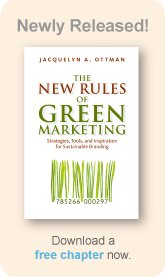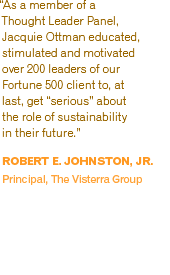What Green Consumer Polls Should Really Be Asking
By Jacquelyn Ottman
Huffington Post — May 3, 2012

Ever since the resurgence of environmentalism in 1990, consumer polls have attempted to measure awareness, attitudes and behaviors towards environmental issues and products. Poll after poll has found that consumers claim to be concerned about the issues, they report high levels of green product purchase, and even claim willingness to pay a premium for greener products and packages.
But empirical evidence doesn't seem to jibe with the research. In some markets, green products barely eke out 3% share, in contrast to the near majorities of consumers who express to pollsters interest in all things green. And despite consumer pronouncements otherwise, premium-priced green brands often gather dust on shelves.
What can explain the gap between the polls and actual in-market performance? Are consumers lying to pollsters in an attempt to look virtuous? Is the spirit willing but the pocketbook weak? Or is it possible that we ourselves need to change the way we view the green consumer market — and ask different questions? I suspect the latter.
What is "green" — exactly?
One of the biggest challenges
in defining "green", whether it be consumers, products or ads, is that
"green," like the planet itself, encompasseseverything — air, water, biological life, chemicals, energy, you name it.
When it comes to zeroing in on "green" products, what constitutes "green" can run the entire gamut of one or more attributes spanning a product's lifecycle starting with raw materials ("sustainably harvested", "organic" and "recycled"), right through to disposal ("compostable", "recyclable,") — and everything in between.
And most consumers can be said to be "green" in some way. For instance, NMI's 2011 US LOHAS Consumers Trends Database found that 83% — an overwhelming majority of consumers — said they identified with green at some level. (Who wouldn't be for green?).
So when majorities of consumers say they are concerned about environmental issues and express interest in buying green products and recycling their newspapers and bottles, chances are they are telling the truth.
Consumers may think they are actually greener than we give them credit for.
Is
it possible that polls may overstate green consumer purchasing and
behavior because consumers think that some of the conventional products
they buy are actually green?
Consider the language on the back of bottle of Tide. Every bottle of Tide, and many other big laundry detergent brands, too, now carries a recycling label and these messages: "Bottle made from 25% or more post-consumer plastic," "Contains no phosphates," "Ingredients include biodegradable surfactants (anionic and nonionic) and enzymes." This all sounds pretty green to me!
Even without such language, is it possible that consumers may believe that trusted brands from reputable companies are "green" — or that the government is watching out?
Do greener products need to scream green via eco-logos and images of planets, babies and daisies to merit a check mark in the "green" column? Consider, too that white vinegar and baking soda have long been touted as green cleaning aids but don't sport eco-logos of any stripe.
There may not even be such as thing as "green" marketing.
When
the FTC Green Guides are issued in revised form (likely this year),
what are referred to as "generalized environmental claims" will most
likely be discouraged. So "green" marketing is really an umbrella term
for educating consumers about the variousspecific environmental
benefits and attributes of one's products or company. Babies, planets
and daisies are quickly disappearing from the vernacular and in their
place are claims for particular environmental attributes.
So the answers to the $64,000 dollar questions of green marketing: Who is the "green" consumer and will she pay a premium for green? may be thatall (or, okay, most ) consumers are green consumers since mostconsumers may think they are already buying green products, however they may define them. And the extent to which they are willing to pay a premium may be no different for "green" than other products and that is: Do they provide value?
The Path Forward
What we seem to be dealing with, then, is a
question of semantics, and the challenge of knowing which questions to
ask to help us understand green market opportunities. "Green" is a
cozy, easy to remember term, but it may not be so useful in
communicating with consumers who likely have their own interpretations
of "green" expressed throughout their day-to-day lives. And misleading
polls results don't help to build credibility for investment among
skeptical businesspeople who for the past 20-plus years have been
hearing that consumers "don't care" and "won't pay a premium".
To those willing to take a shot at rebuilding interest and credibility in all things "green", remember three important things: 1) Most consumers want to do the right thing. They want clean air and clean water, healthful food to eat, litter-free parks and beaches to play in, and energy to run their lives; 2) Whether it be keeping their bathtub clean, saving for retirement, driving the speed limit or eating healthfully, all consumers tend to overstate virtuous behavior to pollsters. (More than we would like, they report the person they aspire to be, or who they are just part of the time.) And; 3) just like forall products, most consumers will only pay a premium when products demonstrate genuine added value.
Although it might take a little doing, most consumers have the wherewithal to understand the building blocks of "green", e.g., "recycled", "recyclable" and "biodegradable". Happily, businesses have the wherewithal to address consumers' needs and to do it sustainably. Their motivations: a competitive advantage, profits, brand loyalty, motivated employees, the ability to innovate, and the promise of a business that will be sustained over time.
My book, The New Rules of Green Marketingincludes detailed strategies and tools for businesses looking to positively address consumers' environmental consciousness without fear of backlash. On the top of the list, is the need for customized research to understand one's own consumers' attitudes and awareness of specific environmental attributes, including carefully segmenting the marketplace, and marketing one's products accordingly.
---
Originally published in Huffington Post on May 3, 2012
Jacquelyn Ottman is an expert adviser on green marketing to Fortune 500 firms, entreprenuerial companies, and the U.S. government. She is the author ofThe New Rules of Green Marketing: Strategies, Tools and Inspiration for Sustainable Branding (Berrett-Koehler, 2011)



 ShareThis
ShareThis
USDA Certification Raises Bar for Biobased
By Jacquelyn Ottman and Mark Eisen
Sustainable Brands — February 20, 2012
With carbon footprint and energy independence on everyone's minds, many marketers are looking to capitalize upon their product's biobased content. But not all biobased claims are alike. The scientific rigor of an ASTM standard combined with the credibility of the USDA raises the bar for the industry and makes the USDA Certified Biobased label a new source of competitive advantage within the consumer and government procurement markets for brand owners who make the effort to get their biobased products certified.
What is "Biobased"?
There is no Webster's definition of biobased. So, marketers have tended to define it loosely or link it to perceptions of biobased as anything biological, living, natural, renewable or even biodegradable. Some do not reveal the amount of, or basis for, claiming biobased content, making comparisons difficult. This can even represent greenwash when biobased content levels are insignificant. Many questionable biobased claims have emerged, including several official-looking logos with no third party backing. With over 25,000 biobased products on the market, clearly there's a need to clear up the confusion.
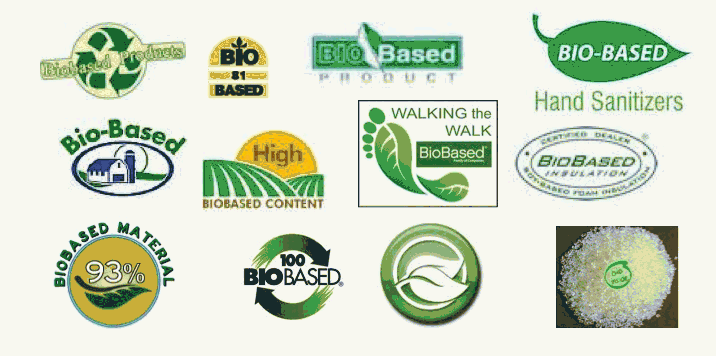
Chart: J. Ottman Consulting, Inc.
Enter the USDA Certified Biobased Label
The USDA Certified Biobased label introduced one year ago this month now helps to level the market for biobased claims by providing a clear definition and an internationally recognized test standard backed up by the credibility of the USDA. Over 500 products have already been approved to use the label, and applications in the pipeline for at least 400 more. (See our previous post for more detail.)
Not just any biologically derived product or package can qualify for the label. Certified products must meet three key criteria: they meet the definition of biobased as written into the 2008 Farm Bill, they contain minimum levels of biobased content set forth by the USDA and verified by the ASTM D6866 test standard (minimums are determined on a category by category basis and are pegged to performance and other criteria), and they represent alternatives to petroleum-based materials introduced after 1972. So, products that were on the market before 1972 made from natural fibers or forestry resources such as cotton tee shirts, office paper, or a 2 x 4 made of pine would not qualify. And neither would products whose biobased content did not meet minimum levels. (See http://biopreferred.gov for more details.)
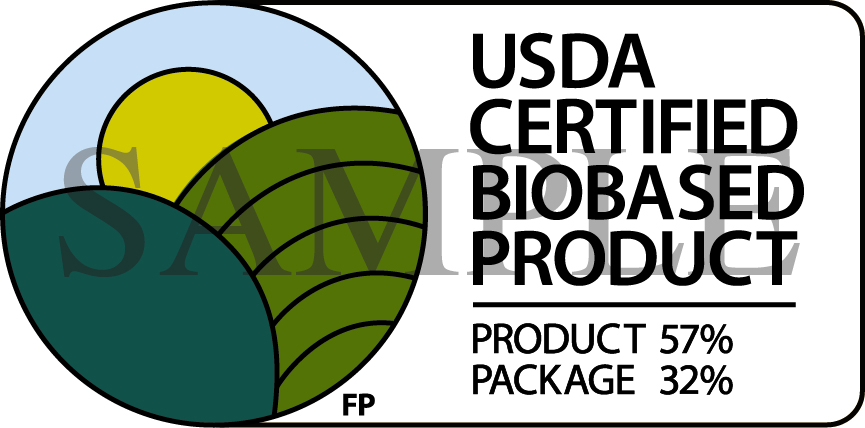
Translating Biobased Content Into Marketing Benefits
The label, with its sun, sea and crops motif was designed to help communicate that biobased products can be derived from the sea or forests — not just grown from plants. For transparency, it requires that the exact percentage of biobased content be listed on the label for the product and/or package. Thus, marketers are provided with a level playing field and consumers have an easy way to identify legitimate biobased products, as well as to compare and trust in their stated content levels.
Marketers can use the label to support a range of benefits including energy independence, alternatives to petroleum, carbon cycle management, enhanced farm and rural economies, and green jobs. Related and specific product environmental benefits as applicable, including renewable, biodegradable, natural, or compostable, must be supported and substantiated with scientific evidence.
Credibility is key. Proprietary formulas safeguarded. The price is right.
The USDA Biobased certification process is administered by ASTM International, an independent third party. Only accredited independent laboratories conduct testing. Since the certification only measures carbon content, no proprietary formulas have to be disclosed. Unlike most other certifications, there is no upfront fee, licensing or royalties, so even the smallest businesses can take advantage of the program. Only a $500 lab test is required — a small price to pay for a potentially big competitive advantage.
Seventh Generation leads the pack.
Seventh Generation has already certified over 35 of their household and personal care products; their motivations: to promote transparency, to avoid greenwash, to allow consumers to make side by side comparisons, and to change the way the industry talks about "natural". In the words of Julia Walker, Associate Scientist of Seventh Generation, "Our consumers want to know where their products originate without being "greenwashed." The USDA Certified Biobased label enables us to disclose the percent renewable carbon in our products, telling consumers how much carbon comes from plants versus petroleum. The credibility of the method will give consumers the confidence they deserve to make conscious choices about their purchases and the products they bring into their homes."
Copyright © 2012 J. Ottman Consulting, Inc.



 ShareThis
ShareThis
Jacquelyn Ottman and Mark Eisen are colleagues at New York City-based J. Ottman Consulting, Inc. They advised USDA BioPreferred on the launch of the USDA Certified Biobased label during 2011 and are now working with labelers on capturing the value of their participation in the program. Ms. Ottman is the author of The New Rules of Green Marketing: Strategies, Tools and Inspiration for Sustainable Branding (Berrett-Koehler, 2011), named a Top 40 Sustainability book by Cambridge University.
Mr. Eisen is the former environmental marketing director at The Home Depot. They are co-authors of "The Rise of the Biobased Economy - Why Brand Owners Need a Strategy in 2012."
How to Choose the Right Eco-label for Your Brand
By Jacquelyn Ottman
Ad Age Good Works Blog, October 11, 2011
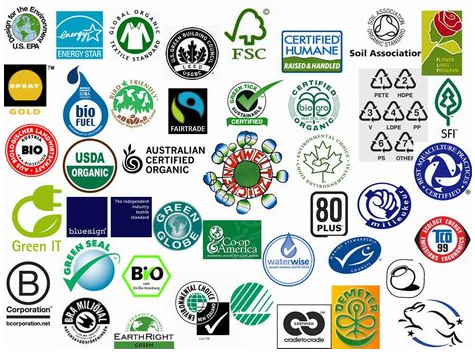 Eco-labels are an excellent way to enhance credibility for green marketing claims, but they are not without risk. While 28% of consumers look to green certification seals or labels to confirm that a product adheres to claims, these labels can also confuse. Happily there's enough method within the madness for marketers to pave a way forward.
Eco-labels are an excellent way to enhance credibility for green marketing claims, but they are not without risk. While 28% of consumers look to green certification seals or labels to confirm that a product adheres to claims, these labels can also confuse. Happily there's enough method within the madness for marketers to pave a way forward.
Eco-labeling challenges
More than 400 different eco-labels or green certification systems are now on the market. Questions such as which label is better, which product is safer for the environment and what does a label even mean are common questions that well-intended green shoppers may find themselves asking when trying to make an environmentally responsible purchase.
Confusion can arise from labels that certify too much or too little information. Some eco-labels focus on a single product attribute (e.g., recycled content), which keeps things simple but can inadvertently mislead consumers into thinking the product is green overall. Other labels look at several characteristics of a product or even a product's entire life cycle; such multi-attribute certifications may raise questions about the credibility of a single attribute-certified product while also preventing easy comparisons.
Some products, such as electrical appliances, have a number of labels and certifications, while others, such as mattresses or flatware, have none. Another common reason for confusion is the discrepancy in the levels of rigor applied to some eco-labeling -- some require independent, third-party verifications while others allow self-certification.
Here are some important criteria to consider when seeking the labeling most relevant to your brand:
Single-attribute labels
Single-attribute seals focus on one environmental issue, e.g., energy efficiency or sustainable-wood harvesting. Before certification, an independent third-party auditor is typically required to verify that the product meets a publicly available standard.
Many single-attribute labels are sponsored by industry associations looking to defend or capture new markets. Others are sponsored by environmental groups or NGOs that want to protect a natural resource or further a cause. Two single-attribute labels with a global presence are the Forest Stewardship Council (or FSC) label, ensuring the sustainable harvesting of wood and paper, and Fair Trade Certified, ensuring that strict economic, social and environmental criteria were met in the production and trade of such agricultural products as coffee.
Voluntary U.S. government labels
Unlike in some countries, such as Canada, Japan and South Korea, the U.S. government has opted for voluntary single- rather than multi-attribute labels. (The private sector and not-for-profit groups hold sway in the area of multi-attribute eco-labeling.) Outside of those associated with independent testing, the government-backed labels don't involve fees.
One of the most visible and influential labels is the U.S. Environmental Protection Agency's ENERGY STAR (for which we at J. Ottman Consulting were proud to advise over many years). ENERGY STAR promotes energy efficiency in more than 60 product categories, and almost 3,000 manufactured products now feature the Energy Star label. In fact, according to the Natural Marketing Institute, in 2009, 93% of the American public recognized the ENERGY STAR label and 73% said they would be more likely to purchase products that carried that label.
Other EPA labels include WaterSense, SmartWay (transportation) and Design for Environment (safer chemicals). The USDA stewards the USDA Organic and USDA Certified Biobased labels (another J. Ottman Consulting client).
Multi-attribute labels
As the name suggests, multi-attribute labels examine two or more environmental impacts. Founded in 1989, Green Seal is the granddaddy of them all. It provides a seal of approval for a variety of products that meet specific criteria on a category-by-category basis. Products are reviewed annually for a fee. A few of the organizations whose products now bear the Green Seal certification include Wausau Paper, Clorox, Kimberly-Clark and Hilton.
Other multi-attribute labels exist primarily for specific categories, such as EPEAT in electronics and Global Organic Textile Standards. Still others address specific areas of concern: for instance, the Carbon Trust's Carbon Reduction label ensuring that the carbon footprint of a product has been measured and is being offset, and the C2C (Cradle to Cradle) label with its emphasis on material chemistry and toxicity. Walmart's Sustainability Consortium promises to eventually deliver multi-attribute guidance in the form of a Sustainable Product Index.
Self-certification programs
Issued by manufacturers to denote their own environmental and social achievements, self-certification programs do not carry endorsements or the credibility of an impartial third party. However, they do provide distinct advantages in controlling costs and providing flexibility in the type and amount of information provided to consumers. Some self-certification systems showcase labels obtained from government or third-party labeling. Companies that have their own self-certification include NEC Corp. (Eco Products), Sony Ericsson (GreenHeart), General Electric Co. (Ecomagination) and Timberland Co. (Green Index).
Independent claim verification
Independent for-profit organizations, including Scientific Certification Systems, Oakland, Calif., and UL Environment, Northbrook, Ill., will verify specific claims for a fee. They will also develop standards in industries where none exist as well as certify products against standards developed by other organizations.
Environmental product declaration
ISO, the International Organization for Standardization, describes three types of eco-labels: Type I: environmental labels; Type II: environmental claims and self-declarations; and Type III: environmental product declarations (EPDs). More often used in Europe and Asia than the U.S., EPDs provide detailed explanations of the full life-cycle impact of a product.
An excellent example is the EPD issued per ISO 14025 by Steelcase for its Think Chair, designed to fit the needs of consumers around the world. Displayed at the company's website, Steelcase.com, the EPD shares the results of three life-cycle assessments (needed to accurately assess impacts in North America, Europe, and Asia), and describes the various certifications it has received from different countries around the globe.
A way forward
Considering an eco-seal endorsement or independent claim certification for your brand or products? Use these suggestions to avoid confusion and maximize the potential value of an eco-label for your brand/product.
1. Choose wisely
Ensure that the organization behind the seal and its methodologies are credible. In particular, look to see that its standards have been developed in accordance with standards-writing organizations such as ISO and local bodies such as the American National Standards Institute or the British Standards Institute.
2. Be relevant
With so many labels available out there, it is quite likely that your brand may qualify for more than one eco-label and product attribute. Thus, aim to promote the attributes that are most relevant to your brand. Also, remember to integrate your eco-labeling into existing brand platforms. GE's well-known Ecomagination designation extends from the company's longstanding "Imagination at Work" brand platform.
3. Educate
Avoid consumer confusion by educating your consumers about the specific criteria upon which your eco-seal is based. When it comes to single-attribute labels, take care to communicate that only a specific product attribute is being certified and that the entire product is not greener as a result. For credibility's sake, if appropriate, communicate attempts to extend the greening process to other product attributes.
4. Be transparent
If you opt to self-certify, be clear that the label is your own. For example, SC Johnson's GreenList label was recently taken to task for appearing to be the work of a third party.
5. Promote your eco-label
Considering that many eco-labels are not widely recognized by the average consumer, help to create demand for your eco-label through marketing communication consistent with your seal's own guidelines. The ENERGY STAR enjoys strong awareness thanks largely to the promotional efforts of the many manufacturers whose products bear the label coupled with advertising. Be sure to look for opportunities to distinguish your commitment to your selected eco-label from competitors using the same label.



 ShareThis
ShareThis
Considered the nation's foremost expert on green marketing, Ottman is also a sought-after speaker and author of four books on green marketing. Her newest book is The New Rules of Green Marketing: Strategies, Tools, and Inspiration for Sustainable Branding (Berrett-Koehler, 2011). It is being hailed as "The New Green Marketing Bible" and "a must read for all marketers." Link here for more information.
Focus on Consumer Self-Interest to Win Today’s Green Customer
By Jacquelyn Ottman
Guardian Sustainable Business Blog - September 23, 2011
If your green ads showcase the now tiresome images of babies, daisies, and planets, your messages will likely be irrelevant to mainstream consumers. Eco-imagery may have tugged at the purse-strings of "deep green" consumers, but their lighter green counterparts, who make up the bulk of the market, want to know how even the greenest of products benefit them personally. While the environment may be the underlying reason a product was created or upgraded, it will likely not be the primary motivation for consumers to choose your brand over those of competitors.
Avoid green marketing myopia
In other words, don't commit the fatal sin of "green marketing myopia". As my colleagues, Ed Stafford and Cathy Hartman of the Huntsman Business School of Utah State, and I point out in our much-quoted article, "Avoiding Green Marketing Myopia," remember that consumers buy products to meet basic needs - not altruism.
When consumers enter a store, they don their consumer, not citizen caps. They are looking to find the products that will get their clothes clean, that will taste great, that will save them money or that will make themselves appear attractive to others. Environmental and social benefits are best positioned as an important plus that can help sway purchase decisions, particularly between two otherwise comparable products.
Quiet Green Marketing
Underscoring the primary reasons why consumers purchase your brand - sometimes referred to as "quiet green" - can broaden the appeal of your greener products and services way beyond the niche of deepest green consumers. Quiet green might also help overcome a premium price hurdle. So, focus communication for greener products on how consumers can protect their health, save money, or keep their home and community safe and clean. Show busy consumers how some environmentally inclined behaviors can save time and effort.
To be clear, this does not mean focusing exclusively on such benefits - to do so would be to go back to conventional marketing altogether. But focusing too heavily on environmental benefits at the expense of primary benefits will put your product in the green graveyard, buried under good intentions. Happily, thanks to advances in technology, many greener products these days do provide added value in the form of enhanced benefits.
Does your green product improve health?
Keep in mind that the number one reason why consumers buy greener products is not to "save the planet" but to protect their own health. Categories most closely aligned with health are growing the fastest and tend to command the highest premiums. Health messages can apply to a wide variety of product categories. Consider, for instance, a print ad for AFM Safecoat (that ran here in the U.S.) featuring 16 buckets of paint; 15 of the buckets are painted red and bear labels such as "Gorgeous Paints," "100% Pure," "Low Odor," and "Sustainable." However, the last bucket stands out in green and announces "The Only Paint that is Doctor Recommended."
Does your product appeal to the style-conscious?
American Apparel was created as a brand that provides excellent working conditions for its employees and uses organic cotton. But, in 2004, when its "sweatshop free" label did not bring in the numbers that CEO Dov Charney was hoping for, he switched to promoting a sexy, youthful image for his company - complete with racy, controversial ads with young women. Three years later, the company has 180 stores and revenue estimated at $380 million. Sounds heretical? Keep in mind that the same sustainably responsible clothing is still being sold to consumers, together with all the same benefits to society and the environment.
Does your product save consumers money?
Many brands find that their green benefits neatly translate into something direct and meaningful to the customer, such as energy savings translating into cost savings. Ads for Sears' Kenmore's HE5t steamwasher state that it uses 77% less water and 81% less energy than older models. The headline grabs readers with the compelling promise, "You pay for the washer. It pays for the dryer." In New Jersey, Marcal's Small Steps campaign positioned the use of 100% recycled household paper products as an easy measure to take for the environment and save money.
Today's consumers want to know the back-story about products and packages, so focus on primary benefits in the context of a full story that incorporates the environment as a desirable extra benefit. Better yet, integrate relevant environmental and social benefits within your brand's already established market positioning, and you've got the stuff for a meaningful sale.
---
Jacquelyn Ottman is a New York City-based expert on green marketing and consultant to Fortune 500 companies and the U.S. government. She is the author of four books on green marketing including the recently released The New Rules of Green Marketing: Strategies, Tools and Inspiration for Sustainable Branding (Berrett-Koehler Publsihing, 2011) Her firm's website, containing more information about the book, is http://www.greenmarketing.com.
Note: This article was first published on the Guardian Sustainable Business Blog.



 ShareThis
ShareThis
Green Paper: Moving Sustainability Forward
By Jacquie Ottman
J. Ottman Consulting - June 2011



 ShareThis
ShareThis
By Jacquelyn A. Ottman, founder and principal, J. Ottman Consulting, Inc., expert adviser on green marketing to Fortune 500 companies and the U.S. government. She is the author of the newly released, The New Rules of Green Marketing: Strategies, Tools, and Inspiration for Sustainable Branding (Berrett-Koehler, February 2011, 252 pp.)
Earth to Eco-Labels: Be Consumer Useful or Wither From Lack of Relevance
By Jacquelyn A. Ottman
Sustainable Life Media, August 5, 2011
Everyone lauds eco-labels being put forth by such sustainability leaders as Timberland, HP and Levi’s for transparency and commitment, but are they really all that useful to consumers? Likely not. These labels may be informative and project credibility, but I believe their usefulness can—and must—be taken up a notch.
An eco-label’s greatest value is not its ability to simply convey environmental stewardship; rather, an eco-label’s worth lies in how clearly it relates green qualities to what I call “consumer-useful” information. Labels with consumer-useful information put the practical, valuable aspects of a product’s environmental attributes front and center. Such labels allow consumers to quantify savings or other sources of added value over the course of a product’s entire lifecycle.
I believe almost every eco-label up until this point has fallen short of this goal —except for the new EPA fuel-economy label, that is. In terms of consumer relevance, the EPA Fuel Economy label sets the bar for a future of eco-labels that motivate rather than simply educate.
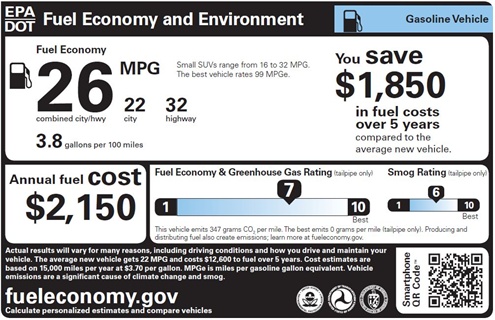
Yes, this EPA label can be applauded for its highly thorough information on greenhouse gas and smog ratings, but its real value lies in its ability to show consumers at the point of sale how much money they can save by buying a greener car. Thus, this label’s most consumer-useful information is the data on estimated annual fuel costs and the fuel savings projected over five years of the car’s ownership.
However ironic it may seem for a green label, this latter information will likely shift more car sales than the environmental data that’s provided due to its practicality (It’s OK to sneak green past consumers, folks.)
It’s the planets, babies and daisies thing all over again.
If our eco-labels only boast of “planet-saving” attributes, their allure will
be short-lived and their impact will be limited. In a marketplace proliferated
by vague, repetitive green claims, it is no longer enough to merely explain
benefits to the planet.
Green marketing means enhancing product quality across the board. That translates into additional product benefits and helping consumers interact with their environment in new ways. Saving money, bettering one’s health, or lengthening a product’s lifespan are all consumer-useful attributes that eco-labels must depict explicitly. Only in doing so will our eco-labels engender stronger motivation to change consumption habits—the goal all along.
So, what can other green communicators learn from this?
Live and learn. In my new book, The New Rules of Green
Marketing, I commend the following companies’ eco-labels,
but the EPA’s new fuel-economy label introduced in May of this year shows me
these companies could do even better.
In the book I congratulate Timberland’s Green Indexas a
watershed mark in transparency, but I now believe it could include more
consumer-useful information. Looking at the Green Index with a consumer useful
lens make me want to see estimates on how long the boots will last (durability)
and whether or not Timberland provides a repair/rebuild service akin to Allen
Edmonds, the fancy men’s shoe maker. Consumers must be able to quantify
benefits and relate green qualities to personal benefits.
HP’s EcoHighlightslabel sports a number of laudable
environmental accolades their printers have earned, but at the end of the day,
consumers might be more interested in how that eco-information translates into
relevant benefits such as ease of double-sided printing, life expectancy and
costs per printed page.
I initially fell in love with the “Levi’s Care Instructions for Our
Planet”label and heartily congratulate Levi’s for including it on
their jeans. However, I now believe that consumers would follow the
instructions (and the planet would be better served) if the primary benefit was
making one’s jeans look good longer.
Think—and Work—Holistically
Ensuring consumer-useful eco-data will take a de-siloing of sustainability and
marketing responsibilities. Only when consumer, environmental and technical advocates
roll up their sleeves at one table will relevant communications be developed.
—-
Additional information on this topic is available from J. Ottman Consulting’s “Moving Sustainability Forward” green paper. Download it here.
Watch Jacquelyn Ottman elaborate on this topic during her kickoff speech to Sustainable Brands ‘11here.
Join The New Rules of Green Marketing LinkedIn Group by linking here.
Originally published by Sustainable Life Media, August 5, 2011



 ShareThis
ShareThis
Jacquelyn Ottman is an expert adviser on green marketing to Fortune 500 companies and the U.S. government. Her firm’s website, containing more information about the book, ishttp://www.greenmarketing.com.
Responsible Consumption: The Next Frontier in Green Marketing
By Jacquelyn A. Ottman
MarketingProfs - March 30, 2011
The following article is adapted from The New Rules of Green Marketing: Strategies, Tools and Inspiration for Sustainable Branding (Berrett-Koehler, February 2011).

Is Tom's of Maine toothpaste really green if consumers leave the water running while they brush their teeth?
Is an ENERGY STAR-rated light bulb really green if it remains on after everyone leaves the room?
It is one thing to design a product to be greener, but the negative environmental impact made throughout a product's life-cycle cannot be minimized unless the consumer uses (and disposes of it) responsibly.
"Responsible consumption"-- what I consider the next frontier of green marketing-is about conserving resources associated with using products. That includes encouraging consumers to use only what is needed and consciously reduce waste.
Sustainability leaders are striving for the ideal goals of zero waste and zero energy, but we will never get to zero until people learn to responsibly consume and properly dispose of the products they buy.
The Consumer's Role in Achieving Responsible Consumption
As any life-cycle assessment will show, consumer usage can account for a significant portion of a product's total environmental impact, especially products such as laundry detergents, soaps, and shampoos that require resources, energy, and water to work.
Manufacturers can design products to make it easier for consumers to minimize resource use, such as a duplex printing feature on a printer, or a dual-flush toilet. Real-time information, such as Toyota's dashboard and the new crop of energy meters and monitoring services, also help. But only consumers can push the "cold" button on the washing machine or turn off the water when they brush.
Industry Incentives to Encourage Responsible Consumer Behavior
Businesses have lots of incentives to encourage such behavior, and some already are pioneering innovative ways to enlist consumer support. That's because, when markets fail to address environmental ills, governments tend to intervene. Witness mandated shifts to energy-, fuel-, and water-efficient appliances, light bulbs, and cars. Will cold-water, laundry detergents, organic cotton, and leather-free shoes be next?
Another issue that industry needs to be mindful of is "the rebound effect"-whereby consumers will buy or use more of a product if it costs less due to enhanced efficiency. A classic example of that is fuel-efficient cars that are driven more miles than less-efficient cars.
Enlisting consumer support for responsible consumption is a surefire way to build credibility and reduce risk. Consumers intuitively understand that it is not possible to spend our way out of the environmental crisis. At the micro level, simply switching one supermarket-cartful of "brown" products with "green" ones will not cure environmental ills. Creating a sustainable society requires (among other things) that every one of us use only what we need and that we help recapture resources for successive use by recycling and composting.
Lessons Learned From Sustainability Leaders
As I learned when advising HSBC on its award-winning "No Small Change" green marketing campaign, a key to the campaign's credibility was empowering people and businesses to reduce their carbon footprint, in line with the bank's own efforts. In other words, we weren't asking HSBC's customers to do anything the bank hadn't done itself.
Sustainability leaders are now winning their stakeholders' respect by communicating the need to consume responsibly, especially in energy use. For starters, HP earned the No. 1 spot on Newsweek's list of the top green companies of 2009 by pledging to reduce product emissions and energy usage 40% from 2005 levels by 2011. Realizing that it needs to partner with consumers to reach that goal, the company has launched its Power to Change campaign, which encourages users to turn off their computers when they do not need them (e.g., at night) and tracks actions to calculate energy and carbon impact.
Another example is Levi Strauss & Co., which teamed up with Goodwill to educate consumers on how to lower the life-cycle impacts of blue jeans. The company's "A Care Tag For The Planet" campaign uses online and in-store messaging, and a new care tag on jeans, to encourage owners to wash in cold water, line dry when possible, and donate their jeans (when they're no longer wanted) to Goodwill thrift stores. The company estimates that such steps by responsible consumers can reduce life-cycle climate-change impacts in half.
Similarly, in Europe, Procter & Gamble's Ariel runs a Turn to 30 (degrees centigrade) campaign to encourage consumers to wash at lower temperatures. Spurred by the threat of regulation, the laundry detergent industry has united to promote responsible washing. And an industrywide Washright campaign launched in 1998 by the Brussels-based International Association for Soaps, Detergents and Maintenance Products (AISE) reached 70% of European households with tips on how to wash laundry in environmentally preferable ways.
A final example is the Sacramento Municipal Utility District, which now knows that peer pressure is an excellent strategy for promoting responsible consumption-and may be even more motivating than saving money.
In a test that began in April 2008, some 35,000 randomly selected customers were told via "happy" or "sad" faces (printed on their monthly utility bills) how their energy use compared with that of their neighbors and the most-efficient energy users in the district. Customers who received the information cut their electricity use 2%, compared with no change by counterparts who did not receive messages. The utility expanded the program to 50,000 households in August 2009.
Originally published on Marketingprofs.com on March 30, 2011



 ShareThis
ShareThis
Jacquelyn Ottman is an expert adviser on green marketing to Fortune 500 companies and the U.S. government. The author of four books on the subject, her latest is the just released,The New Rules of Green Marketing: Strategies, Tools, and Inspiration for Sustainable Branding (Berrett-Koehler, February 2011), 252pp. $21.95. Her firm's website,http://www.greenmarketing.com, contains more information about the book.
We Are All Green Consumers, Now and for the Future
By Jacquelyn A. Ottman
Environmental Leader - February 17, 2011
Green has gone mainstream. Not too long ago, just a small group of deep green consumers existed. Today, 83% of consumers (Source: Natural Marketing Institute, 2009) - representing four generations, Baby Boomers, Millennials, Gen Ys and Gen Zs - are some shade of green. Each in their own way, these generations are quickly transforming what used to be a fringe market that appealed to a faction of eco-hippies is now a bona fide $290 billion industry ranging from organic foods to hybrid cars, ecotourism to green home furnishings.
Teen daughters of yesterday's activist moms search out Burt's Bees lip balm made from beeswax while their "twenty-something" brothers opt to clean their new digs with Method ‘s cucumber-fragranced dish liquid. Today's Dads boast of higher mileage, fewer fill-ups, and the peppy look of their new Mini Coopers or diesel-powered Jettas that get 50-plus miles to the gallon; expect their Gen X sons to be kicking the tires of Nissan's electric Leaf, now heading towards showroom floors.
Thanks to advances in materials and technology, today's "greener" products (defined as having a lighter impact on the planet than alternatives) and today's more "sustainable" products (those that add a social dimension, e.g., fair trade) now not only work well, they likely work better and more efficiently than the "brown" counterparts they were designed to replace.
Channels of distribution have changed have changed, too. As I point out in my just released book, The New Rules of Green Marketing (Berrett-Koehler, February 2011), today, sustainable products are readily available in conventional supermarkets such as Fred Meyer and Safeway, brightly lit emporiums such as Trader Joe's and Whole Foods Market, while mighty Wal-Mart leads the charge towards lifecycle-based standards for products through its groundbreaking Sustainability Consortium.
Once confined to open spaces and rooftops, solar power is now mobile, fueling a modern-day, on-the-go lifestyle embedded in cellphone chargers, backpacks, and even the latest fleet of powerboats. Or confined to the tissue boxes or wrappers of days gone by, recycled content is now good enough for Kimberly-Clark's own Scott Naturals line of tissue products (with its new "coreless role") and Staples' EcoEasy office paper, Patagonia's Synchilla PCR (post-consumer recycled) T-shirts made from recycled soda bottles, and Aveda's Uruku cosmetics packaging made from recycled newsprint, to name just a few.
A sure sign that caring for nature and the planet and the people who live here now and in the future is here to stay - "Sustainability" is a core value of every living generation, starting with the Baby Boomers, the nation's primary household shoppers and societal leaders who led the green charge back in the mid to late-1960s, and extending right through to Internet-savvy Generations X, Y, and Z who promise to transform markets as future decades unfold.
Four Generations of Green
The consuming power of the four current generations is remarkable if marketers can target them by what appeals to them uniquely.
Boomers: The first modern green generation
Now the heads of millions of U.S. households, the Baby Boomers and been influencing society since the 1960s when they planted the seeds of the modern day green movement when as idealistic youths, gathered to celebrate the first Earth Day, in 1970, followed by the first Solar Day in 1971. Their peaceful demonstrations of concern gave rise to the National Environmental Policy Act of 1969, the founding of the US Environmental Protection Agency in 1970, the Clean Air and the Clean Water Acts that same year, and the Endangered Species Act of 1973.
The Middle East oil embargo, marking the beginning of the energy crisis of 1973-75, then focused the Baby Boomers on the need for smaller, more fuel-efficient cars. Witnesses to the 1979 the release of the fictional The China Syndrome, a movie about safety cover-ups at a nuclear power plant, serendipitously opened at theaters two weeks prior to the partial core meltdown at the Three Mile Island nuclear-generating station near Harrisburg, Pennsylvania. They learned first hand about the need for renewable energy.
Taking the values and attitudes they have instilled upon society and have imparted to their children and grandchildren to supermarket aisles, today, over half of Baby Boomers consider themselves socially conscious shoppers. That's 40 million green boomers who, as illustrated in the chart below. choose to organize, pluck resource-conserving products from the shelves, boycott products of companies that pollute, and "pro-cott" the products of companies that give back to the community.
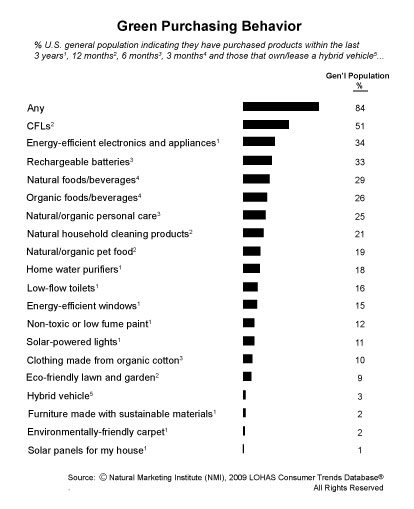
GenX: Eyes on the world
CNN brought global issues into the living room of this generation 24/7. Counting among them actors Leonardo DiCaprio and Cameron Diaz as two of the most outspoken environmentalists of their generation, Gen Xers see environmental concerns through a lens that aligns social, educational, and political issues. They witnessed the fire in the Union Carbide plant in Bhopal India, and the aftermath of the explosion in Chernobyl. In 1985, the Live Aid concert helped to instill in them the need for famine relief in developing nations to an unprecedented 400 million worldwide, and more pointedly, in 1989, Gen Xers saw the massive devastation wrought by the Exxon Valdez oil spill in Alaska.
Millennials: Digital media at their command
This generation grew up in front of computers and unleashing the power of the Internet is second nature to them. Having lived through Hurricane Katrina and the BP Oil Spill, and with growing awareness of the Great Pacific Garbage Patch (the size of Texas), they tend to be distrustful of government and authority, and are quick to challenge greenwash and other marketing practices they deem to be unauthentic or untruthful. With their majority believing that humans cause climate change and the Millenials (aka Gen Y) are twice as likely to buy green products than those who believe climate change is occurring naturally.
Green is an integral part of this generation's college experience. Legions of students now opt for newly created environmental studies courses (and majors) and are active in campus sustainability initiatives. Reusable water bottles and coffee mugs are ubiquitous on college campuses where many savvy companies now reach out with sustainability messages to future householders with significant incomes. Not content to sacrifice all for the almighty dollar, Millennials seek to balance "quality of life" and the "quest for wealth"; they seek to work for socially conscious employers.
As the offspring of the Baby Boomers whose social and environmental values they share, Millennials are the likely new leaders of the modern-day green movement. With the ability to express their opinions through blogging, texting, and social networks, they are capable of mustering immediate responses from millions around the globe.
Generation Z: Green is a natural part of their lives
The first generation to be brought up entirely in an environmentally conscious world, green is part of their everyday life. This generation - currently under the age of 16 - think nothing of living in solar-powered homes with a hybrid car in the driveway. In school and at home the 3Rs of waste management, "reduce, reuse, and recycle," are as common as the 3Rs of "reading, writing, and 'rithmetic."
Sorting paper and plastic for recycling is a normal part of "taking out the trash." As school kids, they likely viewed The Story of Stuff, a 20-minute animated video that divulges the environmental impact of our daily consumption. Environmentally sensitive cleaning aids, locally grown produce, and recycled-paper goods likely top their parents' shopping lists; clothes made from organically grown cotton and biobased fibers are part of their own Gen Z uniform.



 ShareThis
ShareThis
Jacquelyn Ottman is an expert adviser on green marketing to Fortune 500 companies and the U.S. government. The author of four books on the subject, her latest is the just released,The New Rules of Green Marketing: Strategies, Tools, and Inspiration for Sustainable Branding (Berrett-Koehler, February 2011), 252pp. $21.95. Her firm's website, containing more information about the book, is http://www.greenmarketing.com
Eight Myths About Green Products and a Secret about the Hispanic Market
By Jacquie Ottman
Hispanic MPR - Feb 18, 2011
First the secret: Latinos are just as likely as Whites and Asians to be "green" consumers! According to the Natural Marketing Institute, a respected marketing research firm, in 2009, Latinos represented 4% of U.S. population-and 4% of U.S. green consumers, too. What's more, green Latinos tended to be equally distributed among the same types of green segments as Whites and Asians: LOHAS (Lifestyles of Health and Sustainability) - 4%, Naturalites 1%, Drifters (status-conscious) - 4%, Conventionals (resource conservers) 4%, and Unconcerned 3%.
This means that marketers targeting the Hispanic market with the high quality products that Latinos seek, need to heed the same myths of green marketing as the White and Asian marketplaces. These myths of green marketing, as I describe in more depth in my new book, The New Rules of Green Marketing Strategies, Tools and Inspiration for Sustainable Branding include:
Myth #1 Green products don't work as well.
Fact: Method, Tide Coldwater, and Clorox Greenworks brands have been developed specifically to work as well or better than regular products-and command a slight premium price to boot!
Myth #2 Consumers don't want to buy green products.
Fact: Green purchases represented $290 billion in sales in 2008, up from $219 billion in 2005 (Source: NMI, 2009).
Myth #3 Green products are more expensive.
Fact: Thanks to economies of scale due to high volumes, many green products today are competitively priced versus "brown" counterparts; and often can make up for premium pricing many times over during their lifetimes due to savings on energy and water, or simply better performance and value.
Myth #4 Only specialty stores sell green products.
Fact: Major supermarkets now carry their own brand of organic products (e.g., Safeway's 300- item USDA certified "O Organics" line), and Wal-Mart is quickly making "green" a priority for vendor selection.
Myth #5 Green products aren't really "green".
Fact: No product can be truly "green" since all products use resources and create waste, but products can be "greener," denoting a continuum toward sustainability.
Myth #6 Natural products are more healthful.
Fact: Arsenic is a natural substance, yet deadly.
Myth #7 Plant based products will degrade in landfills.
Fact: No product, even those labeled "compostable," will degrade in a landfill. Compostables will only degrade in industrial composting facilities or in backyard composters at high temperatures.
Myth #8 100% recycled products are better for the environment than 10% recycled products.
Fact: Depending upon how far most recyclables must travel to recycling centers for processing (creating greenhouse gases in the process), products with 10% recycled content could actually be environmentally preferable to more recycled counterparts.



 ShareThis
ShareThis
Jacquelyn Ottman is an expert adviser on green marketing to Fortune 500 companies and the U.S. government. The author of four books on the subject, her latest is the just released, The New Rules of Green Marketing: Strategies, Tools, and Inspiration for Sustainable Branding (Berrett-Koehler, February 2011), 252pp. $21.95. Her firm's website, containing more information about the book, is http://www.greenmarketing.com
Focus on Values Drives Growth in Green Consumerism
By Jacquie Ottman
Green Economy Post - February 23, 2011
A radical shift is happening in the marketplace--consumers are increasingly basing purchasing decisions not solely on value, but on their values. As I detail in my new book, The New Rules of Green Marketing: Strategies, Tools and Inspiration for Sustainable Branding (Berrett-Koehler; February 2011), now more than ever, consumers of all stripes are demanding that the brands they buy and the companies that make them, share their own personal social and environmental values.
Consumers are increasingly seeing businesses as linchpins with the resources and the incentives to address pressing societal needs (and this is especially so when government is seen as falling behind or inadequate in this regard.) This perception is changing the rules of the road for marketers who must respond quickly or risk being left behind by offerings viewed as more authentic and committed to sustainability.
Six New Rules of Green Marketing
As I detail in the book, new rules are being written by consumers for manufacturers and marketers.
1. Values guide consumer purchasing. Historically, consumers bought solely on price, performance, and convenience. But today, how products are sourced, manufactured, packaged, disposed of - and even such social aspects as how factory and farm workers are treated - all matter. This green consciousness is not confined to the younger generations. Over half of Baby Boomers consider themselves socially conscious shoppers. That's 40 million green boomers who choose to organize, pluck resource-conserving products from the shelves, boycott products of companies that pollute, and "pro-cott" the products of companies that give back to the community.
2. Life Cycle Considerations are Important. Today's consumers are doing more than just checking prices and seeking out familiar brand names. They turn over packages in search of descriptors that reflect a panoply of environmental and social issues that can impact a product throughout its entire life cycle. In the same breath, consumers can look for products that are at once, "pesticide free" "fair trade" and "sustainably harvested." Representing a sea change in the history of promotion, marketers need to move beyond sheer product benefits in their messages and tell the whole story behind their offerings.
3. Manufacturer and retailer reputation count now more than ever. Not all greener products have ecolabels or green claims emblazoned on them. Many consumers defer to manufacturer and retailer reputations as a defacto eco-label. Consumers are asking, "Who makes this brand? Did they produce this product with high environmental and social standards?" That's one reason why S.C. Johnson is quick to remind us that they are "A Family Company", and why CEOs such as Tom Chappell (Tom's of Maine), Gary Hirshberg (Stonyfield Farm) and Yvon Chouinard (Patagonia) maintain high profiles.
4. Businesses are their philosophies. It used to be that companies were what they made. International Business Machines. General Foods. General Motors. Now, businesses and brands are what they stand for. San Francisco-based Method's innovative line of household cleaning products uses design, fragrance, efficacy, and environmental and personal safety to make cleaning a positive experience for the individual and the environment. Their "People Against Dirty" campaign" featured on the methodhome.com website and their equally empowering "Say no to (laundry) jugs" campaign supporting their new 8X concentrated laundry detergent in waste-free squirt bottle equip consumers with the wherewithal to make a difference.
Meanwhile, "Starbucks proves that a global company serving 50 million people per day can turn a proactive approach to sustainable sourcing and operations into a strategic and profitable part of its brand. And Timberland's attention to quality, passion for the environment and society, and commitment to transparency has helped earn a strong customer following willing to pay its premium.
5. Nearly everyone is a corporate stakeholder. A reflection of the growing social consciousness that exists among today's consumers, corporate stakeholders are no longer confined to just customers, employees, and investors; today, publics of all stripes are now corporate stakeholders including environmentalists, educators, and children - even the unborn. For instance, the astronomic rise in cause-related marketing efforts, now refined to a science helps business such as Starbucks and in turn, their enlightened customers support people living with AIDS in Africa.
6. Authenticity. It's not enough to slap on a recycling logo or make a biodegradability claim. Brands viewed as the most genuine integrate relevant sustainability benefits into their products. That's why HSBC and Stonyfield Farm aim to reduce the carbon impacts of their corporate operations. Their industry-leading track record for managing their carbon footprint (which we at J. Ottman Consulting advised them on) undergirded HSBC's Effie award- winning "No Small Change" green marketing campaign which empowered consumers to reduce their own carbon footprint, in line with the bank's own experience.
© 2011, J. Ottman Consulting, Inc. All rights reserved. Do not republish without permission.



 ShareThis
ShareThis
by Jacquie Ottman, Founder and Principal, J. Ottman Consulting, Inc. An expert adviser on green marketing to Fortune 500 companies and the U.S. government, she is the author of the newly released, The New Rules of Green Marketing: Strategies, Tools, and Inspiration for Sustainable Branding Follow Jacquie on Twitter: @jacquelynottman. Connect with Jacquie on Linkedin. Read Jacquie's Green Marketing Blog.

